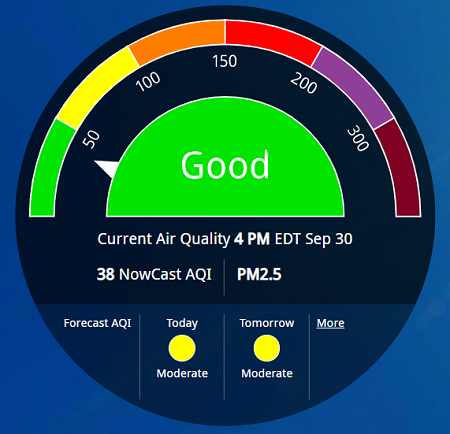Healthy Home: Improve Your Indoor Air Quality During COVID-19
For better or for worse, we have been spending a lot more time inside our homes to stay socially distanced and healthy through the COVID-19 pandemic. But how healthy is the air that you are breathing in your home?
While some indoor air pollutants are relatively mild and can cause minor health problems, long exposure to pollutants like radon, carbon monoxide, or tobacco smoke can lead to life-threatening health problems. Consider these statistics from the EPA:
- We spend on average 90% of our time indoors.
- Indoor concentrations of pollutants are often 2 -5 times higher than outdoor concentrations.
- Those who are most susceptible to indoor pollutants (older adults, young children, those with cardiovascular or respirator diseases) spend more time indoors than average.
- Energy efficient building construction has led to higher average levels of indoor pollutants in recent years.
We have put together the following tips to help you immediately improve the indoor air quality of your home and keep your family healthy and safe.
What is Indoor Air Quality?
Indoor Air Quality (IAQ) is defined by the EPA as the “quality of air inside your home, especially as it relates to your health and comfort”. The EPA recommends improving IAQ in three basic steps.
- Step 1: Removing pollutants and toxins (source control)
- Step 2: Diluting the pollutants with fresh air and improved ventilation
- Step 3: Cleaning and filtering the air
You can improve the indoor air quality of your home to keep your family safe during the COVID-19 emergency by following these simple steps, which we will cover in detail below:
Step 1: Removing Pollutants and Toxins
Doing everything possible to remove the source of the problem should be the first step towards improving the indoor air quality of your home.
Radon
Radon is the second leading cause of lung cancer behind smoking and is responsible for 21,000 deaths in the United States per year (source). Radon gas is naturally present in the atmosphere in trace amounts, but it can become trapped in an enclosed environment like your home.
Take advantage of your time at home to complete a simple do it yourself radon test. You can pick up a test kit at your local hardware or purchase one online. Closely follow the instructions on the kit, as it is important to follow their instructions to receive the most accurate results, and mail it off for results. If your radon levels are higher than what is ideal (above 2.7 pCi/L) you should contact a radon mitigation professional near you.
Secondhand Smoke
Homes are the primary location for children and adults who are exposed to secondhand smoke. Long-term exposure can result in long-term health issues including asthma, heart disease, lung cancer, and stroke.
Establish your home as a smoke-free zone and request that any visitors to your home do not smoke indoors. Improving ventilation and filtering the air in your home can help, but that step should only be taken after entirely removing indoor smoking from occurring in your home.
Mold
High levels of mold in your home can lead to a wide range of health problems such as lung irritation, asthma, or allergic reactions. Many homes are susceptible to high levels of mold, particularly those located in high-humidity locations or homes with flooding or water leaking problems.
High levels of mold in homes is not always obvious and there are many types of house mold that can infest a home. Any location in your home that collects a high level of moisture can be a trouble spot, such as a crawlspace, attic, insulation, carpet, or air vents.
Even through mold mitigation services, it’s virtually impossible to remove all mold and more spores from your home. However mold cannot survive without water, which is why it is critical to reduce the levels of moisture in your home through a variety of methods that could include roofing repair work, home foundation repair, and using a dehumidifier. If you suspect that mold exists in your home, reach out to a mold remediation specialist. Many offer free initial consultations.
Carbon Monoxide
Carbon Monoxide (CO) is dangerous as it is a colorless and odorless gas that at high levels can lead to death. The concentration of CO and length of exposure can vary greatly, but even at low levels people can experience adverse health effects like fatigue, chest pain, impaired vision, and reduced brain function.
CO can originate from a wide range of sources, but they often come from a fuel-burning device that is not functioning properly such as a your home’s fireplace or chimney, your furnace, a gas-powered laundry drying machine, or vehicle exhaust from an attached garage.
Carbon Monoxide detectors should be installed on every level of your house and be spaced properly according to the manufacture’s directions. You should check your detectors and test their alarms on a regular basis to ensure that they are functioning properly. Carbon Monoxide detectors can also expire, so it is important to make sure that you are using detectors that are not past their expiration dates.
If you suspect that a carbon monoxide leak is occurring your home, it is extremely important to immediate open windows and doors to get as much ventilation in your home as possible and to call your natural gas provider immediately.
Wildfire Smoke

Smoke that originates from wildfires can travel for hundreds of miles from the original source and make the outdoor air unhealthy to breathe. Smoke from wildfires will consist of a complex mix of fine particulates and organic materials, which can irritate your respiratory system, eyes, and sinuses. Wildfire smoke and smog and be particularly harmful for young children, older adults, and those with pre-existing health conditions.
Refer to AirNow.gov to get current air quality data for your specific location. Wildfire smoke and smog can cause the Air Quality Index (AQI) to quickly rise to unhealthy levels. As a rule of thumb, an AQI of over 100 should be a cause for concern.
If the AQI in your area is at an unhealthy level, you should keep the windows and doors to your home closed and avoid spending long periods of time outdoors. You can also run your home’s air conditioning or heating system, and ensure that the filter is clean.
Step 2: Diluting Pollutants With Fresh Air & Improved Ventilation
Once you focus on eliminating the source of the problem, you can turn your attention towards reducing the concentration of pollutants in the air by improving ventilation.
Change Your HVAC Fan Setting to On to Increase Air Circulation
As the temperature outside of your home more closely matches the temperature inside your home, your HVAC system will not need to run as frequently. Change the fan setting on your thermostat from “Auto” to “On” to increase the air circulation in your home. If your home is equipped with a fresh air intake, changing this setting will also increase the amount of fresh air you bring into your home.
Utilize Fans That Exhaust Outdoors
Turning on exhaust fans on for longer periods of time can help circulate stale air out of hour home and improve air quality. These could include bathroom and kitchen exhaust fans, attic fans, or running a window air conditioner with the vent control open. Keep in mind that this is a far less energy-efficient solution than utilizing mechanical ventilation.
Open a Window
If your home is not equipped with mechanical ventilation to control the efficiency and quality of fresh air entering your home, you could simply open a window to bring in fresh air. This of course is not practical when the weather is too hot or too cold or for long periods of time, but it is effective if you need to quickly air-out your home.
Step 3: Cleaning and Filtering the Air
Once you have done everything possible to remove the source of the pollutant and improve your home’s air circulation, you can then focus on how to best filter pollutants out of the air.
Change Your HVAC Filter More Frequently
With more time spent at home and increasing the fan circulation setting of your furnace, you should consider changing your furnace filter more frequently. This will prevent the build-up of dust, dirt, bacteria and other pollutants from your home’s airflow.
How often you should change your filter can vary anywhere from 20 days to a year an dependent on many different factors like the size of your home, the type of filter that you are using, how many occupants are in your house, and the number of pets in your house. It is best to consult with a HVAC professional to determine how often you should be changing your filter.
Understand MERV Ratings
An air filter’s Minimum Efficiency Reporting Value (MERV) rating indicates how well the filter is able to capture pollutants that pass through the system. The scale goes from 1-16 with 1 capturing the least amount of contaminants and 16 capturing the most.
Before you buy a MERV 16 air filter, it is important to know that you should only use a filter that is well suited for your HVAC system. Using the wrong type of filter can damage your HVAC system as it may create a high pressure differential that your HVAC system is not designed to handle. Refer to a HVAC professional or your system’s manual to determine the correct MERV filter that you should be using as well as the proper filter dimensions.
Make Your Own DIY Air Purifier
Home air purifiers start at around $200 and can cost over $1,000, which does not take into account the cost of filter replacements. To take a load off your HVAC system and get the benefits of filters with high MERV ratings, the people from This Old House have a clever and inexpensive workaround solution:
Add House Plants
While there are mixed results about how much plants improve IAQ, there are many sources that support the fact that indoor plants improve happiness, and who doesn’t need more of that right now? Potting plants can also be a fun activity for the whole family!
Other Helpful Tips
Avoid Harsh and Toxic Cleaners
Disinfecting your home is important but avoid synthetic fragrances that emit chemicals and volatile organic compounds (VOCs). If you want your home to have a fresh and clean smell, add fresh-sliced lemons or lavender to the cleaning products that you use in your home – not the petroleum-based artificial fragrances.
Be Mindful When Vacuuming
Vacuuming can remove many sources of air contaminants like pet dander and dust, but it can also stir up these particulates and make your home’s air quality worse in the short term. Consider vacuuming with the windows open, wearing a face mask while vacuuming, or only vacuuming while sensitive members of your family are not at home.
Where Can I Find More Details on IAQ and Home Performance?
The home performance industry does more than improve the comfort and efficiency of your home – we have a major focus on health and safety. We invite you to nerd-out with some of our building science colleagues and experts in chemistry, public health, and IAQ on this free series of recorded live-streamed events called The Domino Effect of Quarantine and Responses to COVID-19: What We Know, What You Can Do.
We hope these tips and resources help you to breath better quality air while you keep your family safe at home. Stay well!
